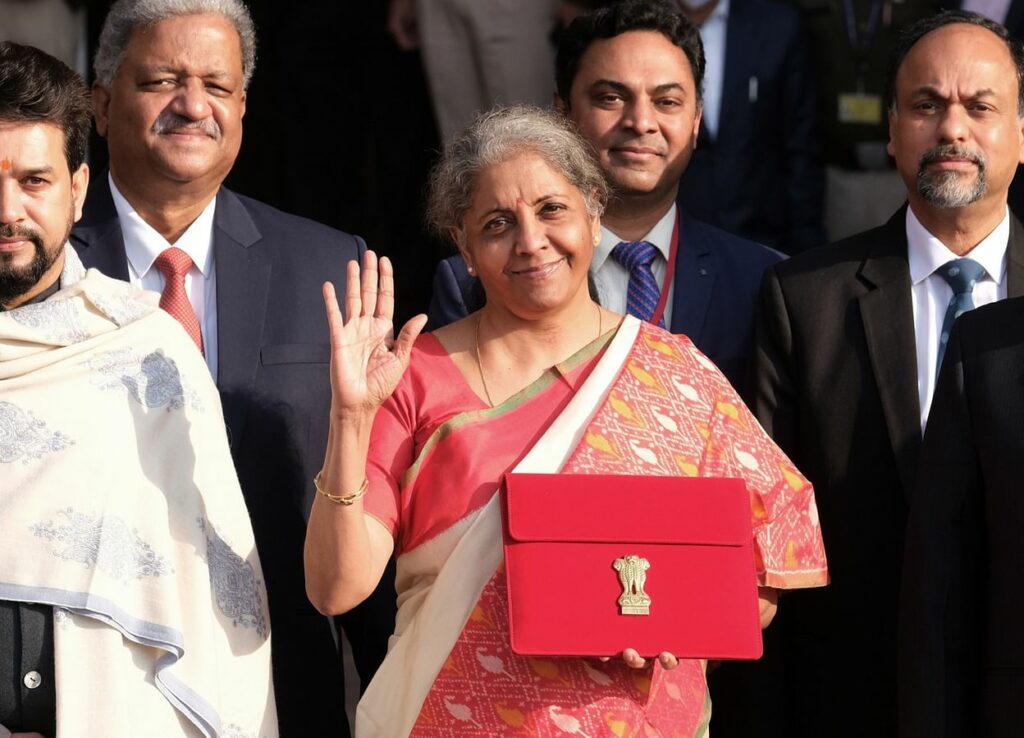India’s Union Budget for the FY 2021-22 presented by FM Nirmala Sitharaman

The Finance minister of India Shrimati Nirmala Sitharaman today announced the union budget of the financial year 2021-22 that would aim to boost the economy which is badly hit by the Coronavirus pandemic. During her 3rd budget speech in Lok Sabha, finance minister said that the government is committed to the wellbeing of the farmers and the MSP (minimum support price) matter has undergone a change. In the current fiscal year, the economy is expected to contract 7.7 %, while the government expects growth of 11 % for the coming fiscal year, following a major Coronavirus vaccination task and a recovery in market demand and investment. .
Now let’s discuss the important key points of the union budget 2021-22:-
These are the six pillars on which we will discuss:-
1. Health and well being.
2. Physical, financial capital and infrastructure.
3. Inclusive development for aspirational India.
4. Reinvigorating human capital.
5. Innovation and R&D.
6. Minimum government and maximum governance.
• Health and Well-Being:
1. Investment in health infrastructure increased substantially.
2. PM Atma Nirmbhar Swasthya Bharat Yojna will be launched.
3. Rs 64,180 crore spending plan for healthcare over the next six years. This is in addition to the National Health Mission.
4. 17,000 rural and 11,000 urban health and wellness centres to be set up.
5. Integrated public health labs to be set up in each district.
6. This will develop capacities of primary, secondary and tertiary healthcare.
7. 3,500 crore for covid vaccine in 21-22. Committed to provide more if required.
8. Health outlay: Over 137% increase YoY.
9. Urban Swachh Bharat Mission 2.0 will be rolled out with an outlay of Rs 1.48 trillion over 5 years.
• Physical, financial capital and infrastructure:
1. Voluntary vehicle crapping policy soon.
2. Vehicles to undergo test.
3. Personal vehicles – 20 years. commercial – 15 years.
4. For a 5 trillion economy, manufacturing has to grow in double digits on a sustained basis.
5. Textiles – Mega investment textile park scheme will be launched. This will be in addition to the PLI scheme.
6. 7 textile parks will be established over 3 years.
7. 217 projects have been completed.
8. NIP is a specific target which is the govt. is committed to achieve.
9. Infra needs long term debt financing.
10. A new bill to develop a new institution.
11. Lending portfolio of 5 lakh crore for this DFI within 3 years.
12. National Monetisation Pipeline for brown filed assets will be launched.
13. NHAI and PGCIL to play a key role.
• Inclusive development for aspirational India:
1. 500 km of national highway works in Tamil Nadu at an investment of 1.03 lakh crore.
2. 1100 km in the state of Kerala at an investment of Rs 6500 crore.
3. 6075 km in West Bengal at a cost of Rs 25,000 crore.
4. 1.18 lakh crore for Ministry of Road Transport and Highways for Ministry of Roads and Transport.
5. Railway has prepared a national rail plan for India 2030.
6. WDFC and EDFC will be commissioned by June 2022.
7. Son Nagar-Gomosh section EDFC will be taken up under PPP.
8. New dedicated freight corridors- Itarsi-Vijaywada, Kharagpur-Vijayawada and Bhusawal-Dankuni.
9. Vistadome coaches in tourist routes.
10. Automatic train protection system in busy corridors.
11. Over 1 lakh in capital infrastructure.
• Reinvigorating human capital:
1. Urban infra – New scheme at a cost of Rs, 8,000 crore for bus transport augmentation in cities.
2. 1,016 km of metro lines is under construction in the country.
3. Central counterpart funding will be provided to kochi metro phase 2.
4. Chennai Metro phase, Bengaluru metro phase 2a and 2b, Nagpur metro phase 2 and Nashik metro will also receive central counterpart funding.
5. Distribution companies are monopolies.
6. There is a need to provide choice to consumers.
7. A framework will be put in place to allow consumers to choose between more than one provider.
8. A framework to be put in place to give consumers alternate to choose more than one distributing company.
9. New Power scheme outlay: Rs 3, 05, 984 crore over 5 years.
• Innovation and R&D:
1. A new scheme to facilitate flagging of ships in India.
2. Ships recycling – Efforts will be made to bring more ships to India.>
3. 7 projects worth Rs 2000 crore will be offered at major ports in FY21-22.
4. Scheme for promoting flagging of merchant ships: Outlay Rs 1,624 crore over 5 years.
5. Ujjwala Scheme to cover 1 crore more beneficiaries.
6. 100 more cities to be covered under city gas supply network.
7. 1000 crore to solar energy commission.
• Minimum government and maximum governance:
1. No restriction on paid-up capital and turnover, to incentivise incorporation of one-person companies.
2. Conversion of one-person company to any other kind, reducing residency limit from 182 days to 120 days Allow non-resident Indians to incorporate one-person companies in India.
3. The FM proposed to revise definition under Companies Act, 2013 for small companies by increasing their threshold for capitalization to not exceeding Rs 50 lakh to not exceeding Rs 2 crore and turnover not exceeding Rs 2 crore to not exceeding Rs 20 crore.
4. Government allots Rs 20,000 crore for bank recapitalisation, as FM emphasizes the need to clean up banks’ books.
5. FDI limit in insurance increase to 74% from 49%.
6. FM proposes to consolidate provisions of SEBI Act, Depositories Act, Securities Contracts Regulation Act, Government Securities Act.